Rust, Germany – Monday, March 29th, 2010
“Everyone in Europe speaks English!” Thus I flew over the Atlantic under the belief that statement was somehow truthful. After I arrived in Italy and discovered that doesn’t apply to all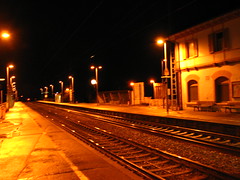 European countries, just a few (notably England), I was then told, “Don’t worry, that’s just in the Mediterranean regions! Everyone in places such as Germany, the Netherlands, or Sweden speaks English!” I sure hope at least that is true because my German is limited to perhaps all of three words.
European countries, just a few (notably England), I was then told, “Don’t worry, that’s just in the Mediterranean regions! Everyone in places such as Germany, the Netherlands, or Sweden speaks English!” I sure hope at least that is true because my German is limited to perhaps all of three words.
As nice as it is to have a train service which makes it possible to get from one random small town to another, it does take a lot longer and there’s a bigger risk of waiting on a train platform waiting to catch the later connection because your last train was late. That was the situation I found myself in as I was trying to make my way from Haßloch to Rust. Since I’m now not expecting to arrive until closer to 11pm and still have to make my way from the neighboring town where the station is located to get to my accommodations, I figure I best give them a call so they down close up for the night before I arrive and if there’s a better way to get over there than walking. The place I booked was the cheapest I could find online, but it was described as a “Ferienwohnung” and I wasn’t entirely certain what sort of accommodations that entailed.
“Hirsch” says the voice.
“Hello, does someone there speak English?”
A hesitant pause. “Nein.”
Ah, one of my three words of German, put to very good use.
Robbed of the ability to use hand gestures, pointing or even drawing which have proven vital to communicating when there’s a language barrier, after a bit of fumbling I’m finally able to get two of the important concepts communicated “Jeremy Thompson” (I get a positive reaction indicating he recognizes the name on their reservations for the night) and “Ringsheim Bahnhof”. Now I just need to get “late” or “eleven”. Such simple concepts. Impossible to describe without other simple concepts. Such is one of the paradoxes found in the philosophy of language. I finally decide to just call out to random strangers in the station if anyone can help translate. I’m greeted with blank looks by a first group of people, but down a staircase I find a woman who offers to help. I explain what I need to communicate and then give her the phone. She remains in conversation for at least five minutes, at times appearing to me to be getting a lot of concerning information. Is there a problem? Finally she finishes, and informs me there’s no problem I will be arriving at 11pm, they will have a car at the train station to pick me up. “Oh, that’s wonderful!” I thank her for her help,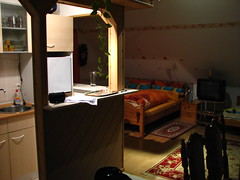 and she insists it was no trouble as it was something to do while she waits for her train.
and she insists it was no trouble as it was something to do while she waits for her train.
True to her word, there was the car waiting for me outside the train station. The owner of the Ferienwohnung seemed somewhat stumped by me but nevertheless did more than necessary to welcome and help me. “Danke,” being my second word of German, was used liberally (“Bahn” being my third). Upon our arrival I discovered Ferienwohnung is a description of a guestroom the couple has on the upper floor of their home. He insisted on giving me a full tour of the room, how to use the television, coffee maker, the showers, etc. The room unfortunately was not heated, but the blankets were as insulating as I’ve ever found, making it very challenging to arise from bed the next morning 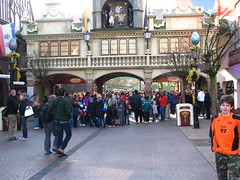 to take an ice-cold shower and prepare for my first day at Europa Park.
to take an ice-cold shower and prepare for my first day at Europa Park.
I don’t think even the most basic of communications was needed for it to be plainly obvious to the couple my reasons for visiting Rust, and they instantly drew me a map of how to get from their house to the Europa Park front gate. “Yeah, yeah, simple,” I think to myself, “just walk in the direction where you see the huge-ass roller coasters everywhere”, which are sort of a hard sight to miss. Rust is an extremely strange town in as much as it seems to be a small, quiet, quaint little German village, almost entirely small cottages and homes with an extremely limited commercial sector, save for the western side of town, which is totally dominated by Europe’s largest theme park with 230ft. roller coaster structures sticking into the sky. The contrast is quite striking, to say the least.
sticking into the sky. The contrast is quite striking, to say the least.
I arrived about 45 minutes after the park opened, and was surprised to find that a semi-decent guest population had already arrived, despite being a Monday in March when the last four parks I visited from Thursday to Sunday were all dead. I suppose that’s to be expected of places that are able to make it to the elite category of “destination parks”. Nevertheless, while the place was lively the rides are all designed to be capacity monsters, and I had not more than a ten minute wait to get the front row of Silver Star (running only two trains) to begin my time at Europa Park.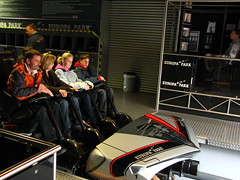
To say I boarded Silver Star with low expectations was an understatement. I have a pretty good critical record of not being particularly enthusiastic about most of their coasters from the past decade (around the time when they stopped contracting with Werner Stengel and did their own design work), which are generally unimaginative, dull, and poorly paced. I think some people mistook my criticism to be that they aren’t forceful or as intense as other rides, which I admit might factor slightly into my personal distaste for their products, but in fact I think that a 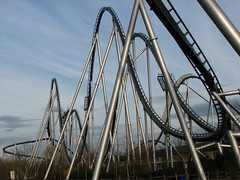 gentle ride which offers a smoother flying sensation could be done very well (that’s the semi-official stance I take towards Millennium Force), but there still has to be other sorts of substance or the experience is akin to listening to New Age music, it’s nice if the context is an elevator but it’s not all that interesting. That’s not to say that I don’t recognize the impressive scale of the investment in relation to other less towering attractions, or that I think Silver Star doesn’t deserve its status as one of the park’s signature attractions. But after hearing reports from fans of B&M speed coasters that they felt Silver Star was the most overdrawn and least interesting of this particular genre, I had good reasons to be concerned that the whole experience would be a total duff.
gentle ride which offers a smoother flying sensation could be done very well (that’s the semi-official stance I take towards Millennium Force), but there still has to be other sorts of substance or the experience is akin to listening to New Age music, it’s nice if the context is an elevator but it’s not all that interesting. That’s not to say that I don’t recognize the impressive scale of the investment in relation to other less towering attractions, or that I think Silver Star doesn’t deserve its status as one of the park’s signature attractions. But after hearing reports from fans of B&M speed coasters that they felt Silver Star was the most overdrawn and least interesting of this particular genre, I had good reasons to be concerned that the whole experience would be a total duff.
 I came back pleasantly surprised. More surprised by the pleasant surprise than the pleasant surprise itself. To be sure I gave it three to four rerides in other seats, and still found my impressions to be tipped toward the positive side of the scale. A gentle, smoother flying sensation, yes, one of my personal favorites, no, but it seemed to accomplish what it set out
I came back pleasantly surprised. More surprised by the pleasant surprise than the pleasant surprise itself. To be sure I gave it three to four rerides in other seats, and still found my impressions to be tipped toward the positive side of the scale. A gentle, smoother flying sensation, yes, one of my personal favorites, no, but it seemed to accomplish what it set out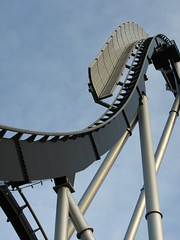 to do without too many points that I had me thinking something better could have been in its place. Most crucially the airtime was present in every location in was supposed to be, which had been one of my primary concerns after hearing stories of an overtrimmed ride which barely gets 0 g’s in any seat other than the back, especially after Expedition GeForce the previous day seemed to have molasses coating its wheels due to early season slumps. It was no stronger than anything found on Diamondback or
to do without too many points that I had me thinking something better could have been in its place. Most crucially the airtime was present in every location in was supposed to be, which had been one of my primary concerns after hearing stories of an overtrimmed ride which barely gets 0 g’s in any seat other than the back, especially after Expedition GeForce the previous day seemed to have molasses coating its wheels due to early season slumps. It was no stronger than anything found on Diamondback or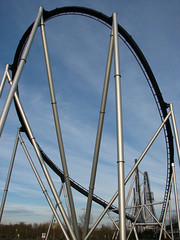 Nitro, but it did not suffer a worse fate than Raging Bull. Perhaps it being early season meant it was running just slow enough to prevent the trims from triggering, as it was difficult to feel if they were having any affect.
Nitro, but it did not suffer a worse fate than Raging Bull. Perhaps it being early season meant it was running just slow enough to prevent the trims from triggering, as it was difficult to feel if they were having any affect.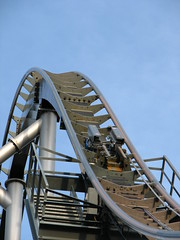
Fans of speed coasters may be satisfied with this review so far, however I’ve still yet to describe anything that might put it a notch above other speed coasters I’ve been more critical toward. I think the parts where it wasn’t doing straight camelback hills but instead was attempting some sort of turning maneuver worked better for me. The turn into the first major camelback hill after the first drop helps it sustain the speed a bit longer and makes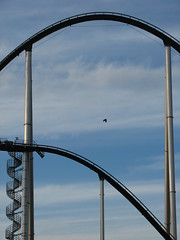 the entry into the first airtime crest a bit more interesting, and the swishy S-curve into the far turn around gives it more character than the perfectly symmetrical, one-note hammerhead curves found on other designs, plus as the turn is more spread out there’s a more distinctive change of pace which helps highlight the gentle ‘flight’ sensations they might be going for. Admittedly the second half isn’t quite as strong, but even things like a slight rightward tip on the dive out of the spiral are more interesting than what B&M have been serving up on the drop profiles of more recent examples, and the final sudden S-curve between some trees and into the brakes is a surprisingly vital pace change for a last second exclamation point, a trait conspicuously absent from other designs. Unfortunately the first drop is the worst out of any speed coaster, a big bowl of steam from the front row made worse by a large sound shield obscuring the view on the right side. However, I’m more forgiving towards bad first drops as by the time I get to the end when I’m forming my opinion on the experience, that’s the first thing I’ll have forgotten.
the entry into the first airtime crest a bit more interesting, and the swishy S-curve into the far turn around gives it more character than the perfectly symmetrical, one-note hammerhead curves found on other designs, plus as the turn is more spread out there’s a more distinctive change of pace which helps highlight the gentle ‘flight’ sensations they might be going for. Admittedly the second half isn’t quite as strong, but even things like a slight rightward tip on the dive out of the spiral are more interesting than what B&M have been serving up on the drop profiles of more recent examples, and the final sudden S-curve between some trees and into the brakes is a surprisingly vital pace change for a last second exclamation point, a trait conspicuously absent from other designs. Unfortunately the first drop is the worst out of any speed coaster, a big bowl of steam from the front row made worse by a large sound shield obscuring the view on the right side. However, I’m more forgiving towards bad first drops as by the time I get to the end when I’m forming my opinion on the experience, that’s the first thing I’ll have forgotten.
I think what most aided my relatively positive reaction was that between my two days there I never had to wait any longer than the first time I waited 10-15 minutes for the front, and most of the time I could get a walk-on provided I quick enough to spot a group of two or three about to board a certain row; on my second day I managed about 10 rides in a period not much more than 45 minutes, most of the time spent walking down the exit ramp back to the exit. In that way it was an inoffensive treat, fun for a kick of smooth airtime on one of the few coasters built in Europe of a scale comparable to a signature Cedar Fair or Six Flags attraction (even going as far as to re-create the parking lot setting, a rarity for a European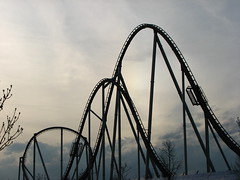 theme park) so I could hardly complain about its existence. Could a better, more interesting ride have been built? Absolutely. Did I care? Not so much today. Mostly I just wished they could cut that insidiously repetitive surf rock Silver Star theme music in the station. One final thought, while I appreciate their resistance to painting it the brightest shades of red, orange or blue as is the trend with every B&M installation at a Six Flags or Cedar Fair park, was the drab granite track and silver supports really the best palate they could come up with? To me it suggests they’re almost ashamed of its profile and are trying to hide it as much as possible.
theme park) so I could hardly complain about its existence. Could a better, more interesting ride have been built? Absolutely. Did I care? Not so much today. Mostly I just wished they could cut that insidiously repetitive surf rock Silver Star theme music in the station. One final thought, while I appreciate their resistance to painting it the brightest shades of red, orange or blue as is the trend with every B&M installation at a Six Flags or Cedar Fair park, was the drab granite track and silver supports really the best palate they could come up with? To me it suggests they’re almost ashamed of its profile and are trying to hide it as much as possible.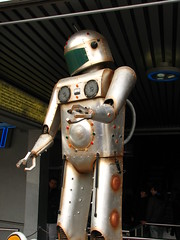
My next ride also in the French area ended up being another pleasant surprise: Eurosat. At first glance it would appear to be nothing but an obvious rip-off of Space Mountain from Disneyland inside a rip-off Spaceship Earth from Epcot, and essentially that is what it is. However, this spherical geometry brings with it special consequences for the coaster housed inside. When Disney builds their coasters they’ve realized that the conic ‘mountain’ shape is the best geometrical figure to house them within, as there’s less space towards the top when the train is slower, and gradually more space towards the bottom as the train increases in speed, requiring wider elements (plus simply a larger percentage of the track length needs to be closer to the ground due to friction). A sphere doesn’t allow this. They have the most lateral room in the middle, but towards the end of the ride they have to design even tighter elements when the speed should be at its fastest. Can you think of many other spaghetti-bowl coasters which could be tightly encased by a spherical structure? It’s just not natural, is it?
 Building a lifthill to the top which isn’t super-steep is another problem with the spherical design, but Europa Park solved this one by building a rotating spiral lift which takes the better part of three minutes to reach the top. Plenty of time to build anticipation as I became encased in an ever-more robust darkness, the space-age music and countdown to launch drowning out the screams from trains before ours.
Building a lifthill to the top which isn’t super-steep is another problem with the spherical design, but Europa Park solved this one by building a rotating spiral lift which takes the better part of three minutes to reach the top. Plenty of time to build anticipation as I became encased in an ever-more robust darkness, the space-age music and countdown to launch drowning out the screams from trains before ours.
Once the coasters leaves the lift it becomes a descent into insanity, there being no single large drops to give the train a boost of speed, just the continuous downhill maneuvering through a tightly wound collections of curves, switchbacks, helices, figure eights, and the odd block brake. Each section builds on the last 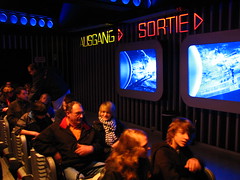 until it gets to the point where its whipping through turns so fast it hardly feels legal, especially considering we’re blinded by the darkness and can hardly anticipate when it’s suddenly going to dodge to the left or right again. Some glow in the dark asteroids and warp tunnel effects make an appearance later in the ride, but by that point I’m mostly focused on making it to the brake run alive. Thankfully the cars are of a roomy, minimalist design with nothing more than a simple lapbar meant I wasn’t having to fight to protect myself from encumbering restraining devices on the hard turns, and made it by far one of the most breathtaking and thrilling roller coasters I’d find in Europe. An underrated gem and an absolute must ride, this is also the only coaster I’ve seen with an escalator in the queue!
until it gets to the point where its whipping through turns so fast it hardly feels legal, especially considering we’re blinded by the darkness and can hardly anticipate when it’s suddenly going to dodge to the left or right again. Some glow in the dark asteroids and warp tunnel effects make an appearance later in the ride, but by that point I’m mostly focused on making it to the brake run alive. Thankfully the cars are of a roomy, minimalist design with nothing more than a simple lapbar meant I wasn’t having to fight to protect myself from encumbering restraining devices on the hard turns, and made it by far one of the most breathtaking and thrilling roller coasters I’d find in Europe. An underrated gem and an absolute must ride, this is also the only coaster I’ve seen with an escalator in the queue!
Also in the French section of the park was the Euro-Tower, a 75 meter tall observation deck, which I ascended to get a collection of photos surveying the rest of the park landscape:
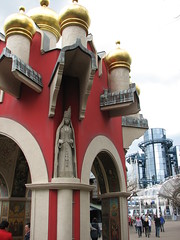 One thing I noted and appreciated (this was also true at Holiday Park) was that each of the employee’s name tags had little flags on them indicating which languages they spoke; most had a French or British flag next to the German, sometime all three, and it became a game to spot workers with flags from other locales, or even find a few with four or more flags. The degree of multilingualism in Europe is quite embarrassing to the United States, where it seems to be believed that learning another language is more of a hobby than a necessity (which it sort of is over there). I remember in high school there being a special recognition assembly for students completing the upper-level language classes, and one girl was given a special plaque for being able to hold a full telephone conversation with a representative from a German-language institution, which seemed quite an impossible feat to the rest of us. Over here, that’s to be expected of anyone under the age of 40 (if not universally in English), and whenever I got in conversations with anyone I would want to make apologies on behalf of Americans for how we expect everyone to speak English for us wherever we go.
One thing I noted and appreciated (this was also true at Holiday Park) was that each of the employee’s name tags had little flags on them indicating which languages they spoke; most had a French or British flag next to the German, sometime all three, and it became a game to spot workers with flags from other locales, or even find a few with four or more flags. The degree of multilingualism in Europe is quite embarrassing to the United States, where it seems to be believed that learning another language is more of a hobby than a necessity (which it sort of is over there). I remember in high school there being a special recognition assembly for students completing the upper-level language classes, and one girl was given a special plaque for being able to hold a full telephone conversation with a representative from a German-language institution, which seemed quite an impossible feat to the rest of us. Over here, that’s to be expected of anyone under the age of 40 (if not universally in English), and whenever I got in conversations with anyone I would want to make apologies on behalf of Americans for how we expect everyone to speak English for us wherever we go.
As you perhaps already know, the majority of the rides and attractions in Europa Park are designed by MACK Ride, who own the park and use it as a sort of large-scale showroom and proving ground for their rides. I heard from someone who thought I might be against this concept at Europa Park since it seemed from some of my other reviews I was critical towards parks which had any corporative motives less pure than making the best possible theme park they know how. That’s true only to the extent with which those ulterior motives start to influence what sort of experience the guest receives, especially when it’s an overt push toward idealizing consumer culture (i.e. spending millions on a dark ride system which provides not much more than an expensive display of technology in service of promoting whatever f ranchised intellectual property they have the rights to). In all other cases corporate motives are essential to moving resources and getting things built, and in the case of Europa Park I think it’s an excellent system and one more ride manufacturers should try, at least those with a diverse enough portfolio to support an entire
ranchised intellectual property they have the rights to). In all other cases corporate motives are essential to moving resources and getting things built, and in the case of Europa Park I think it’s an excellent system and one more ride manufacturers should try, at least those with a diverse enough portfolio to support an entire 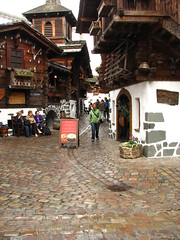 theme park. The incentive to design unique, fun and well-presented rides is increased because they’re not only trying to sell their products to park visitors, but potentially to other parks as well. It’s also beneficial to the manufacturer, as it gives them greater license to develop new concepts with the knowledge that they’ll have at least one guaranteed buyer. The greatest limitation is of course if Mack doesn’t offer the ideal range of products that Europa Park would desire, partly evident in their lack of a world-class roller coaster until they bit the bullet and hired B&M to work for them (the Mack representatives must have an awkward job when touring potential buyers around who spot Silver Star and ask “what’s that really big ride over there?”), but now they also have Blue Fire and I don’t feel the park is any lacking for their exclusive relationship with Mack.
theme park. The incentive to design unique, fun and well-presented rides is increased because they’re not only trying to sell their products to park visitors, but potentially to other parks as well. It’s also beneficial to the manufacturer, as it gives them greater license to develop new concepts with the knowledge that they’ll have at least one guaranteed buyer. The greatest limitation is of course if Mack doesn’t offer the ideal range of products that Europa Park would desire, partly evident in their lack of a world-class roller coaster until they bit the bullet and hired B&M to work for them (the Mack representatives must have an awkward job when touring potential buyers around who spot Silver Star and ask “what’s that really big ride over there?”), but now they also have Blue Fire and I don’t feel the park is any lacking for their exclusive relationship with Mack.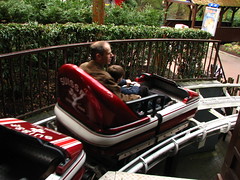
One of these corners where the park is more obviously ‘Mack showroom’ is the Switzerland section, which contains at least two of the staple Mack products, each contained in its own square plot of land and presented with some very extensive Swiss themeing (the small stream of water running through the midway that guests would have to step over was a great touch). The first ride I’d try is a classic, the Schweizer Bobbahn. Despite having about four trains on it the capacity’s not the greatest, owing to the six car trains which each car sits only one or two people, depending on if sitting on one’s lap is kosher to both parties. I’d recommend avoiding this one during peak times of the day.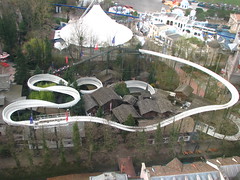
Assuming you are sitting by yourself like me, the seats offer plenty of legroom and a very simple lowering bar leaves me not feeling much more secure than if I were on a tilt-a-whirl. After the lift there’s a flat turn at the top which lets one survey the French area of the park, and then a straight drop and rise. This first part made me a little uneasy, because I generally assume that when you’ve got a coaster train with no upstop or guide wheels, most of the track should be designed as banked curves and helices to keep the cars pinned to a specific trajectory thanks to centrifugal force, not regular straight drops and hills which the cars could seemingly slide any which way they should choose.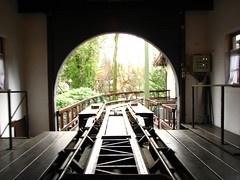
After this there’s a quick block brake to slide through, and then the rest of the ride is what I’d expect from a Mack Bobsled, a series of slightly downhill s-curves, eventually progressing all the way to a few helices, and then a final brake run. Some themed structures such as a brief tunnel make an appearance toward the end, but the final brake run comes too soon after just when this section becomes interesting. On the transitions between turns there was an odd effect where the cars wouldn’t follow a heartlined path but instead seem to navigate over a slight ‘bump’ in the trough where it made the banking change, feeling more uneasy when very loosely strapped into free-wheeling cars.
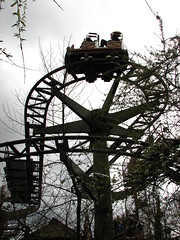 Right next door was the newer but no less Mack-essential Matterhorn Blitz, one of their large park wild mouse models with some nice scenery interaction and an impressive vertical lift. Think Pilgrim’s Plunge but on a much smaller vertical scale (translating to larger relative outward curvature on the bends) and indoors. I’m fairly certain if Mack wasn’t the owner of Europa Park wanting to show off this technology it would never have been built, which would be a loss as it may have been the highlight of the entire ride. The rest was identical to every other instance of this model wild mouse I’ve been on, save for the nicer themed surroundings and an absence of reiterative trim braking, making the last switchbacks at the end actually feel like part of the ride and not an extended brake run as on Canada’s Wonderland’s or Kings Dominion’s versions. One of the better examples of a simple, production model roller coaster done well enough to warrant a reride or two.
Right next door was the newer but no less Mack-essential Matterhorn Blitz, one of their large park wild mouse models with some nice scenery interaction and an impressive vertical lift. Think Pilgrim’s Plunge but on a much smaller vertical scale (translating to larger relative outward curvature on the bends) and indoors. I’m fairly certain if Mack wasn’t the owner of Europa Park wanting to show off this technology it would never have been built, which would be a loss as it may have been the highlight of the entire ride. The rest was identical to every other instance of this model wild mouse I’ve been on, save for the nicer themed surroundings and an absence of reiterative trim braking, making the last switchbacks at the end actually feel like part of the ride and not an extended brake run as on Canada’s Wonderland’s or Kings Dominion’s versions. One of the better examples of a simple, production model roller coaster done well enough to warrant a reride or two.
Also in the Swiss area was Jungfrau Gletscherflieger, a spinning flat ride with biplane cars that circled each other from suspended arms. From the midway it appeared a very chaotic scene, but once I was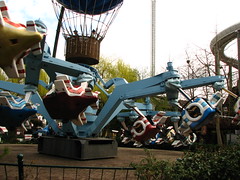 on the ride and could easily track the way the cars were made to rotate about each other it was rather boring. Not sure if I’ve ever seen a model like it anywhere before, however. Nearby back in the French section was another dark ride, Universe of Energy, which sounded like something I’d find at Epcot, but instead was just an odd collection of B-movie dinosaur animatronics, apparently connecting the ‘educational’ energy theme to the fact we get our fossil fuels from Tyrannosaurs? (??) Apparently there were a couple other dark rides and a Mack exhibition hall that I missed located in the Italian section of the park. It did strike me that for as many opportunities that Italy offers to create an immersive theme zone, Europa Park seemed to have skimped out on their Italian section, as only the Ciao Bambini dark ride has any apparent connection
on the ride and could easily track the way the cars were made to rotate about each other it was rather boring. Not sure if I’ve ever seen a model like it anywhere before, however. Nearby back in the French section was another dark ride, Universe of Energy, which sounded like something I’d find at Epcot, but instead was just an odd collection of B-movie dinosaur animatronics, apparently connecting the ‘educational’ energy theme to the fact we get our fossil fuels from Tyrannosaurs? (??) Apparently there were a couple other dark rides and a Mack exhibition hall that I missed located in the Italian section of the park. It did strike me that for as many opportunities that Italy offers to create an immersive theme zone, Europa Park seemed to have skimped out on their Italian section, as only the Ciao Bambini dark ride has any apparent connection to the peninsula, the other dark ride is still named the Geisterschloss.
to the peninsula, the other dark ride is still named the Geisterschloss.
At this point I went on to explore deeper into the park, taking in the Greek, Russian, Scandinavian and Icelandic portions of the park, which I will cover in more detail tomorrow. I will say however that my impression of the Europa Park aesthetic wasn’t as explosive as I felt it had a reputation for. It was a theme park, with lots of attention to landscaping and detail, but not much more special than that. It’s on flat and limited land, so they have to squeeze all the rides and shops together along a basic midway structure with something always there trying to catch your attention around the next corner. The busyness of bright colors and loud rides was replaced with a busyness of lots of themed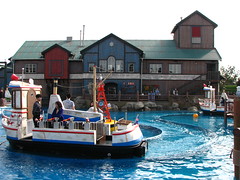 buildings and displays with rides constructed over and inside the edifices, it never managed to ‘transcend’ the theme park experience like one might find in the most beautiful and cared-for parks around the world. That was my impression mostly sticking to the upper side of the park (away from the town of Rust) where all of the big rides were located; on the other side of the park it was a very different story. Almost no action at all, save for the occasional flat ride or interactive display, just walkways and gardens. I appreciate the inhomogeneity of the layout, but I didn’t think it came off as naturally as places like Alton Towers or even Busch Gardens Europe, and the lack of any crowds back there honestly reflected the area’s dullness as not being an essential component of the park experience (this also led to some crowd-management issues
buildings and displays with rides constructed over and inside the edifices, it never managed to ‘transcend’ the theme park experience like one might find in the most beautiful and cared-for parks around the world. That was my impression mostly sticking to the upper side of the park (away from the town of Rust) where all of the big rides were located; on the other side of the park it was a very different story. Almost no action at all, save for the occasional flat ride or interactive display, just walkways and gardens. I appreciate the inhomogeneity of the layout, but I didn’t think it came off as naturally as places like Alton Towers or even Busch Gardens Europe, and the lack of any crowds back there honestly reflected the area’s dullness as not being an essential component of the park experience (this also led to some crowd-management issues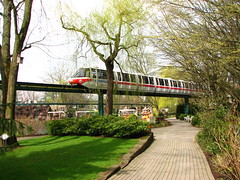 with the more popular sections). If the exact same ideas had been built over an area 1/3 larger and integrating more natural terrain elements (along the lines of Alton, Busch or Terra Mítica) it could have been a tremendously special experience, but as it was it was just ‘quite good for a big theme park’, one which grew up with the original Six Flags and Paramount Parks but maintained the original vision rather than succumb to high returns on lowest possible expenses. This isn’t a complaint, but I suspect many fans want to declare it something more than that. Just an observation.
with the more popular sections). If the exact same ideas had been built over an area 1/3 larger and integrating more natural terrain elements (along the lines of Alton, Busch or Terra Mítica) it could have been a tremendously special experience, but as it was it was just ‘quite good for a big theme park’, one which grew up with the original Six Flags and Paramount Parks but maintained the original vision rather than succumb to high returns on lowest possible expenses. This isn’t a complaint, but I suspect many fans want to declare it something more than that. Just an observation.
At the end of my day I took a long walk around the parking lot getting photos of Silver Star’s layout, then began to wander back to my room for the night. Did I know how to get back?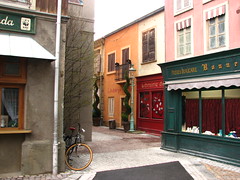 “Yeah, yeah, just walk in the direction of the… houses… which all look identical.” Crap, why didn’t I think to take more detailed notes on how to get back when I left that morning? I have the quick directions they drew me, but there’s no road labels, and after getting as close as I can remember, it becomes obvious I’m still off by a couple blocks. A man on his front lawn with his family sees me looking
“Yeah, yeah, just walk in the direction of the… houses… which all look identical.” Crap, why didn’t I think to take more detailed notes on how to get back when I left that morning? I have the quick directions they drew me, but there’s no road labels, and after getting as close as I can remember, it becomes obvious I’m still off by a couple blocks. A man on his front lawn with his family sees me looking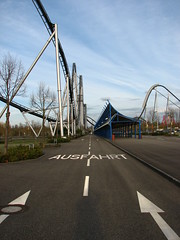 lost and I find out he speaks some English. I try to describe where I’m staying, which he’s never heard of, but I still have my phone with the number in it so I give it a call and he offers to translate directions for me. Not only that, but he insists on walking with me over there so I’m sure I’ve found the right location. He and guesthouse owner share a five minute conversation while I stand there red-faced, only vaguely recognizing they’re discussing this idiot’s lack of any German skills. As I return I offer the owner the two euro I was short on when paying for my stay the night before, but he flatly refuses and insists I keep it for myself. I want to go on record saying that German people are so incredibly nice and helpful, it’s impossible to think that within a single generation back in history this very same country was responsible for teaching the rest of the world the joys of National Socialism.
lost and I find out he speaks some English. I try to describe where I’m staying, which he’s never heard of, but I still have my phone with the number in it so I give it a call and he offers to translate directions for me. Not only that, but he insists on walking with me over there so I’m sure I’ve found the right location. He and guesthouse owner share a five minute conversation while I stand there red-faced, only vaguely recognizing they’re discussing this idiot’s lack of any German skills. As I return I offer the owner the two euro I was short on when paying for my stay the night before, but he flatly refuses and insists I keep it for myself. I want to go on record saying that German people are so incredibly nice and helpful, it’s impossible to think that within a single generation back in history this very same country was responsible for teaching the rest of the world the joys of National Socialism.






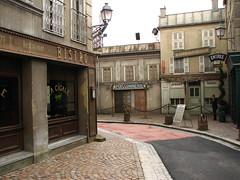
POV videos of Schweizer Bobbahn and Matterhorn Blitz